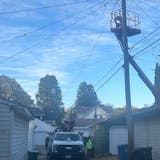More than $1 billion from a pair of infrastructure bills is headed to the Twin Cities metro area, with the money expected to kickstart road and bridge construction, fund more than 50 nonprofit organizations and launch upgrades to parks and community sports centers.
Many of the largest projects have been on the back burner for years as communities waited for state aid. Some local leaders said they were "ecstatic" to see spending for major projects across the state, especially after the 2022 legislative session ended without a bonding bill. Metro-area city and county governments and nonprofits will account for almost $1.04 billion in a mix of borrowing and cash from the $2.6 billion infrastructure package Gov. Tim Walz is expected to sign Thursday in Minneapolis — the largest in state history.
"We feel really good we can move forward with our projects," said Brooklyn Park City Manager Jay Stroebel.
Still, some requests remain unfilled.
Minneapolis had hoped for $10 million to help make sidewalks compatible with the Americans with Disabilities Act, but settled for $2 million from a state transportation bill. And two requests went unanswered: $9 million for upgrades to the Minneapolis Convention Center and $17 million for design and repair of the Nicollet Avenue South bridge over Minnehaha Parkway and Minnehaha Creek. Those projects remain on hold.
But lawmakers did fully fund the city's request for $9.9 million for the Central City Tunnel project, an ongoing $58.3 million effort to expand storm tunnels that drain into the Mississippi River, some of which date to the 1800s.
"That was really one of our top bonding priorities because it was underway, and we're working toward getting that completed," said Katie Topinka, Minneapolis government relations director.
The state infrastructure package also includes $1.7 million for updating the Emergency Operations Training Facility in Fridley. Primarily operated by the city of Minneapolis, the facility will offer new training for firefighters, including rescues from a collapsed roof or caved-in trench.


